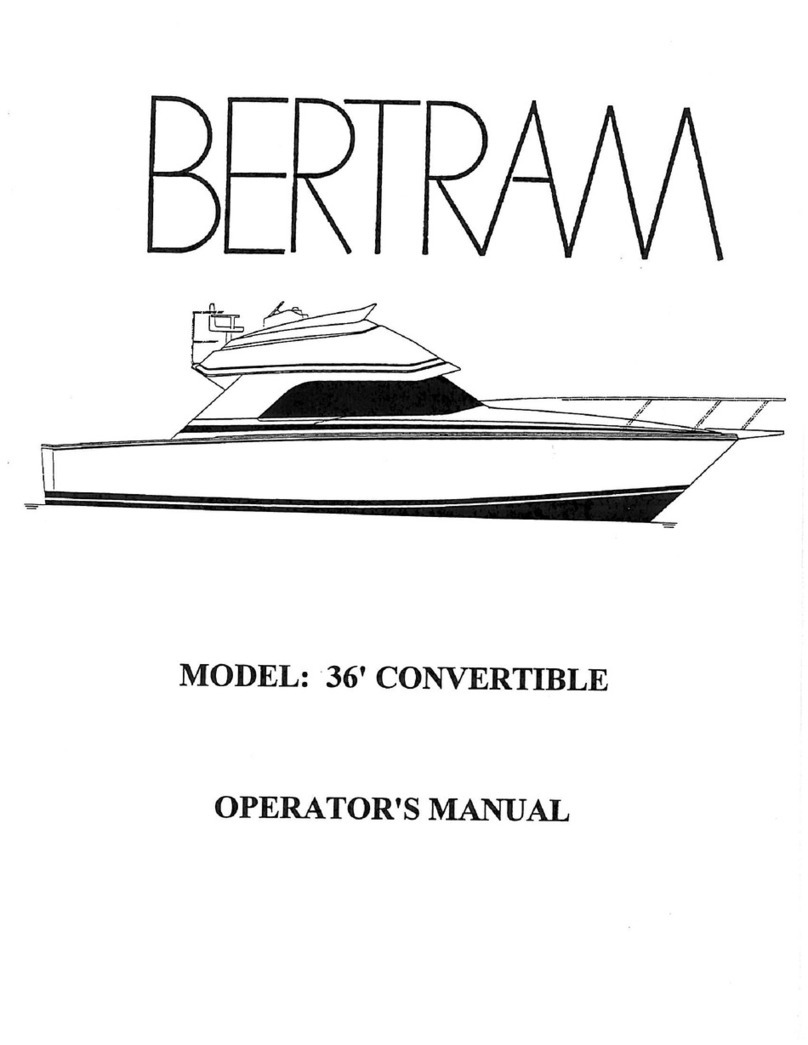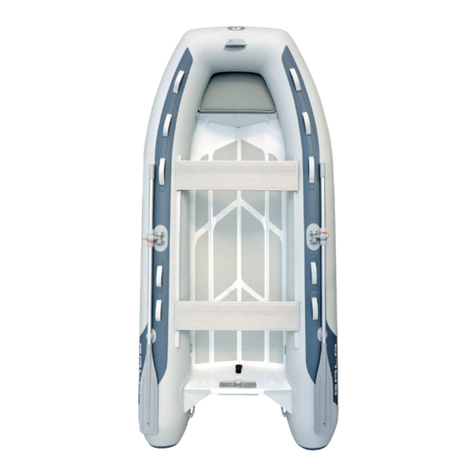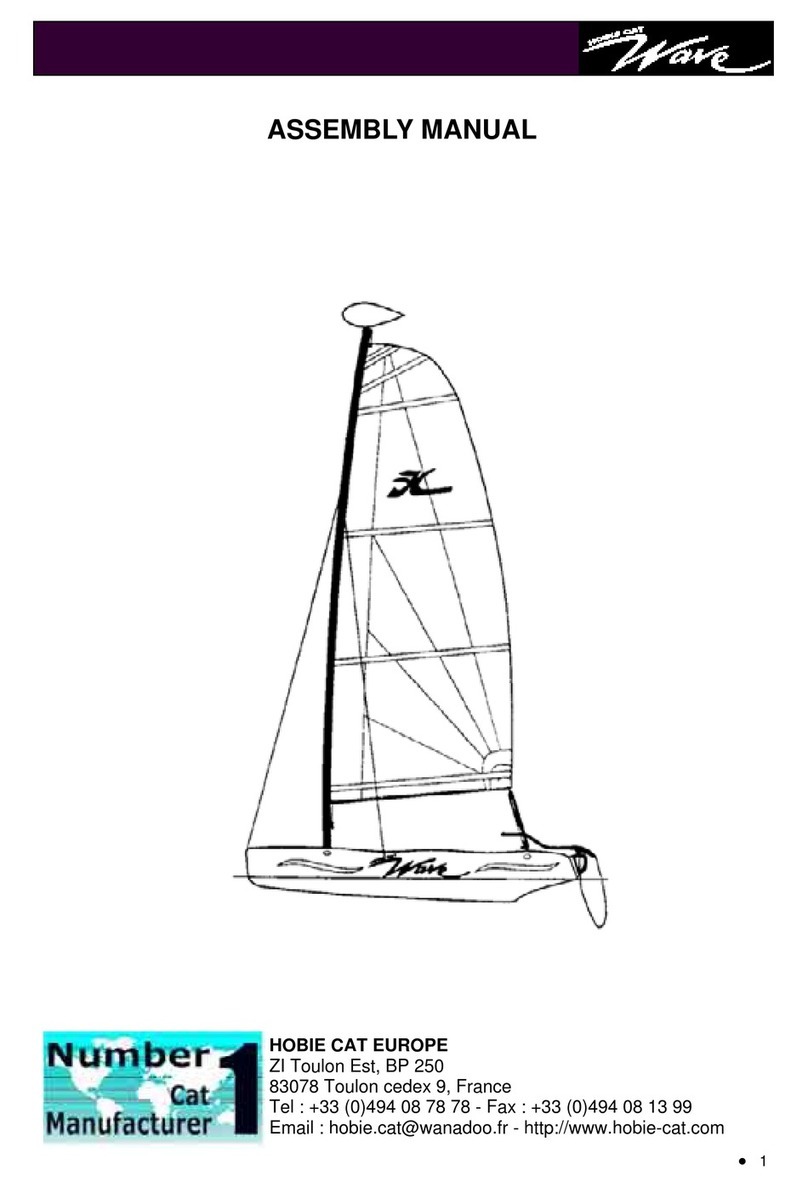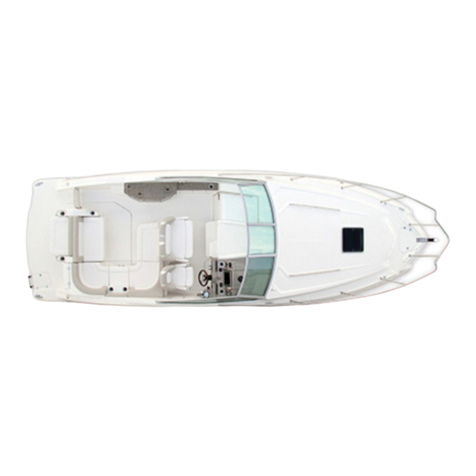SEALEGS 7.5M HYDRASOL RIB User manual

OWNER’S MANUAL – 7.5m


CONTENTS
1. Introduction...........................................................................................................................1-1
About This Manual ......................................................................................................................................... 1-1
Explanation of Symbols and Labels ............................................................................................................ 1-1
2. Before Operating Boat ...........................................................................................................2-1
Before Use Of The Boat .................................................................................................................................. 2-1
Outboard Run-in Times.............................................................................................................................. 2-1
Responsibility ............................................................................................................................................. 2-2
Seaworthiness and Crew Ability................................................................................................................. 2-2
Boat Warning and Caution Labels .............................................................................................................. 2-3
3. Operating the Boat ................................................................................................................3-1
The Console – 7.5m semi-cab rib ............................................................................................................... 3-1
The Console – 7.5m rib .............................................................................................................................. 3-2
Keypad Symbol Index................................................................................................................................. 3-3
OPERATIONAL Introduction............................................................................................................................ 3-5
Before Each Journey....................................................................................................................................... 3-6
Recommended Safety Equipment.............................................................................................................. 3-6
Passengers and Crew ................................................................................................................................. 3-6
Boat Visual Check....................................................................................................................................... 3-6
Weather and Water Conditions ................................................................................................................. 3-7
Driving the Amphibious Boat on Land ............................................................................................................ 3-8
Starting the Inboard Engine ....................................................................................................................... 3-8
Steering, Acceleration and Deceleration.................................................................................................... 3-8
Recommended Inboard Run Time ............................................................................................................. 3-9
Terrain........................................................................................................................................................ 3-9
Driving into the Water .................................................................................................................................. 3-11
Entering the Water .................................................................................................................................. 3-12
Operation on the Water ............................................................................................................................... 3-13
Visibility from Main Steering Position...................................................................................................... 3-14
Using the Outboard and Trim .................................................................................................................. 3-14
Navigation Lights...................................................................................................................................... 3-15
Risk of Loss of Stability ............................................................................................................................. 3-15
Risk of Flooding........................................................................................................................................ 3-16
Protection from Falling Overboard .......................................................................................................... 3-17
Exiting the Water.......................................................................................................................................... 3-18
Preparing to Exit the Water ..................................................................................................................... 3-18
Exiting the Water ..................................................................................................................................... 3-19
Turning off the Inboard............................................................................................................................ 3-19
Lowering the Boat on Land........................................................................................................................... 3-20
Lowering the Legs on Land....................................................................................................................... 3-20
4. Operational Options ..............................................................................................................4-1
Braking & ABS (Automatic Braking System).................................................................................................... 4-1
After Each Journey.......................................................................................................................................... 4-2
Leaving and Securing the Boat................................................................................................................... 4-2
Anchoring, Mooring and Towing .................................................................................................................... 4-3
Towing ....................................................................................................................................................... 4-3
Mooring ..................................................................................................................................................... 4-4
Trailering .................................................................................................................................................... 4-4
Trucking ..................................................................................................................................................... 4-5
Xtended Run Time (XRT) Operation................................................................................................................ 4-5
Xtended Run Time (XRT) Warning Features ............................................................................................... 4-5
Xtended Run Time (XRT) Alternator........................................................................................................... 4-6
Fuel System .................................................................................................................................................... 4-6
Priming the Fuel System ............................................................................................................................ 4-7
Fire Fighting Equipment ................................................................................................................................. 4-7
Inboard Engine Fire Port Location and Operation...................................................................................... 4-7
Risk of Fire.................................................................................................................................................. 4-8
Battery Operation........................................................................................................................................... 4-9
Normal Use ................................................................................................................................................ 4-9

Battery Charging......................................................................................................................................... 4-9
Emergency Starting .................................................................................................................................... 4-9
5. Care and Maintenance .......................................................................................................... 5-1
Petrol and Oils ................................................................................................................................................ 5-1
Petrol Requirements .................................................................................................................................. 5-2
Inboard Motor Oil ...................................................................................................................................... 5-2
Tyres and Rims................................................................................................................................................ 5-3
Hull and Fittings .............................................................................................................................................. 5-4
Outboard Maintenance .................................................................................................................................. 5-4
Tube Maintenance.......................................................................................................................................... 5-4
Tube Pressure............................................................................................................................................. 5-4
Tube Cleaning............................................................................................................................................. 5-5
Suspected Tube Leaks ................................................................................................................................ 5-6
Hydraulics ....................................................................................................................................................... 5-6
Steering System.......................................................................................................................................... 5-6
Sealegs Hydraulic System ........................................................................................................................... 5-7
Fire Fighting Equipment Maintenance............................................................................................................ 5-8
Electrical System and Battery Maintenance ................................................................................................... 5-8
Safe Operation of Electrical Systems.......................................................................................................... 5-8
Battery Maintenance ...................................................................................................................................... 5-9
Battery Disconnection and Removal .......................................................................................................... 5-9
Electrical System Description........................................................................................................................ 5-10
Electrical System Maintenance ..................................................................................................................... 5-11
Bilge - Bilge Pumps, Bungs, Scuppers and Seacocks ..................................................................................... 5-12
Bilge Pumps.............................................................................................................................................. 5-12
Through Hull Fittings ................................................................................................................................ 5-13
Scheduled Maintenance ............................................................................................................................... 5-14
Service Schedule Summary........................................................................................................................... 5-15
Service Interval Table ............................................................................................................................... 5-15
6. Environmental Awareness..................................................................................................... 6-1
Tread Lightly ................................................................................................................................................... 6-1
Leakage of Petrochemicals ............................................................................................................................. 6-2
Household Waste, Black and Grey water........................................................................................................ 6-2
Noise............................................................................................................................................................... 6-2
Wash/ Waves.................................................................................................................................................. 6-3
7. Sealegs Owner Frequently Asked Questions......................................................................... 7-1
8. Sealegs Warranty .................................................................................................................. 8-1
Introduction ............................................................................................................................................... 8-1
Warranty Period......................................................................................................................................... 8-1
Items Included Under This Warranty ......................................................................................................... 8-1
Warranty Exclusions................................................................................................................................... 8-2
Obtaining Warranty Coverage.................................................................................................................... 8-3
Transfer ...................................................................................................................................................... 8-4
Limitations of Liability ................................................................................................................................ 8-4
9. CE Declaration 7.5m RIB....................................................................................................... 9-1

Introduction 1-1
1. INTRODUCTION
ABOUT THIS MANUAL
This manual has been compiled to help an owner safely operate and maintain their Sealegs
Amphibious Boat. Please read this manual carefully to become familiar with the boat before use.
This manual is designed to comply with the Recreational Craft Directive (RCD) and should not be
perceived as an exhaustive guide to the vessel. This manual is to be read in conjunction with
regional regulations required for local operation, the OEM manuals supplied for specific products
(e.g. outboard, electronics, steering), and additional boat safety training course materials.
Please keep all manuals in a secure place and hand over to the new owner if the boat is sold.
Explanation of Symbols and Labels
The boat and this manual show symbols which advise the owner/operator and crew of imperative
safety precautions to follow when operating and/or servicing equipment. The following
descriptions are used. They should be respected at all times.
Danger
Denotes a
n extreme intrinsic hazard exists which would result in high
probability of death or irreparable injury if proper precautions are not taken.
Warning
Denotes a hazard exists which can result in injury or death if proper precautions
are not taken.
Caution
Denotes a reminder of safety practices or directs attention to unsafe practices
which could result in personal injury or damage to the boat or components.
Information
Denotes useful or important facts or suggestions that can greatly enhance
safety and efficiency of operations.
The following additional symbols may be found on fittings and components on board the boat.
They should be respected at all times.

Before Operating the Boat 2-1
2. BEFORE OPERATING BOAT
BEFORE USE OF THE BOAT
Before using a Sealegs Amphibious Boat it is important the operator familiarizes themselves with
its operation and safe use. If the operator is unfamiliar with this type of boat, for comfort and
safety, ensure they obtain handling and operating experience before assuming command of the
boat. It is strongly recommended that:
•The operator fully reads this manual, and understands the boat’s operation, maintenance and
safe use. A manual however is not a replacement for experience and common sense.
•A complete detailed visual check of the boat is made before initial use, and before each
subsequent journey
•All safety and emergency equipment is checked and confirmed to be correctly located on
board (including appropriate lifejackets for all users, and ensuring the boat has a full
emergency kit including flares and first aid kit on board), and all operators and passengers of
the boat know how to operate this safety equipment
If the boat is being used for the first time, the following should also be checked:
•If an anchor is included with the boat, then the anchor should be checked that it is attached
correctly to the rope and chain, and attached securely to the boat
•That the tube pump is assembled and operation understood
The operator should be familiar with the location and functionality of the controls
and all safety and emergency equipment before operating the boat on the land or
water.
Outboard Run-in Times
Some outboard engines require a run-in period. The separate outboard owner’s manuals included
in the document pack should be consulted for detailed instructions on the operation and
maintenance of the outboard fitted to the boat.

Before Operating the Boat 2-2
Please refer to the outboard manual for specific run in details for the type of
outboard fitted. For example, there is a 10 hour run- in period for the Yamaha
outboards.
Responsibility
It is the boat owner/ operator’s responsibility to:
•Know the limitations of the boat
•Follow the rules of the road
•Keep a sharp lookout for people and objects in the water
•Ensure that the anticipated wind and sea conditions will correspond to the design
category of the boat and that the operator and crew are able to handle the boat in these
conditions
•Never operate when under the influence of drugs or alcohol
•Be aware of the crew/ passenger’s safety at all times
•Ensure all crew receive suitable training, particularly with regards to location and
operation of safety equipment
•Reduce speed when there is limited visibility, rough water, people in the water nearby,
boats or structures
•Ensure the boat is properly maintained at all times
•Have the boat inspected by qualified personnel at regular intervals and whenever a cause
for concern is raised
•Ensure compliance with all legislation in place in the area of operation. These may include
requirements for the carriage of life saving equipment, licensing of the helmsman and
respect for the environment
The owner and users of the boat are responsible for determining its suitability for any and all
selected uses and assumes all risks in connection therewith when used, including the safety of
persons and property, and only operating the boat under safe conditions. It is recommended all
users undergo a marine safety course before going to sea.
Seaworthiness and Crew Ability
Regardless of the boat’s seaworthiness and its certified RCD design category, protection from
freak sea and wind conditions cannot be guaranteed. The ability, experience and fitness of the
crew should therefore be taken into consideration before making any voyage.

Before Operating the Boat 2-3
As a minimum, ensure that the anticipated wind and sea conditions will correspond to the design
category of the boat and that the crew are able to handle the boat in these conditions. See page
5-15 for the RCD design category and description.
Any boat, no matter how strong it may be, can be severely damaged by misuse.
Always maintain the boat properly. Make allowances for and ensure necessary
maintenance is performed to allow for the deterioration that will occur over time
as a result of use or misuse of the boat.
Boat Warning and Caution Labels
Before operating the boat, ensure the crew have read and understood all labels affixed to the
boat.
Do not remove or obstruct any safety label. Replace any label which becomes
illegible.
7.5m Semi-Cab RIB
7.5m RIB

Before Operating the Boat 2-4

Before Operating the Boat 2-5

Operating the Boat 3-1
3. OPERATING THE BOAT
This boat will provide hours of enjoyment when used and cared for in accordance with these
instructions. Please take the time to learn to operate the boat correctly and safely.
The Console – 7.5m semi-cab rib
Outboard Controller
Outboard Ignition
Battery Isolator
Engine ON/OFF
Bow Wheel
Stern Wheel
Speed Joystick
Inboard Throttle
Outboard Trim

Operating the Boat 3-2
The Console – 7.5m rib
Outboard Controller
Outboard Ignition
Battery Isolator
Engine ON/OFF
Bow Wheel
Speed Joystick
Inboard Throttle
Outboard Trim
Stern Wheel

Operating the Boat 3-3
Keypad Symbol Index
Horn
Headlight
Navigation/Anchor Light
Floodlights
Underwater Lights
Anchor Up
Anchor Down
Bilge Pump
Ambient Lighting
Washdown Pump
Windscreen Up
Windscreen Down

Operating the Boat 3-4
If a button on the keypad flashes red, it means there is a fault with that circuit.
Hold down for 5 seconds or until red light stops flashing to reset the circuit. Try
the circuit again and if it starts flashing red again, it means there is a blown fuse
or software issue. In this instance, please contact your nearest service technician.
Bow Wheel Up
Bow Wheel Down
All Wheel Drive/
2-Wheel Drive
Engine ON/OFF
Stern Wheel Up
Stern Wheel Down
Throttle Up
Throttle Down

Operating the Boat 3-5
OPERATIONAL INTRODUCTION
The following sections provide more detail on how to operate the boat on the land, launching, on
the water, and returning to land ready for storage.
A Sealegs has two propulsion systems – one for land, and one for sea. On water, the outboard
engine(s) provides the power to propel the boat. On land, the inboard engine provides the power
to drive the boat, and to raise and lower the legs. The main controls to operate the boat are
located on the console, as detailed on the previous page.
On water, the Outboard Controller with integrated trim switches controls the outboard(s). The
steering wheel is used to steer the boat on the water.
On land, the inboard engine provides the power for the wheels. Once the inboard engine is
running, the forward and reverse speed of the boat is controlled by the Speed Joystick . Pushing
the joystick forward moves the boat forward, and pulling the joystick backwards reverses the
boat. Returning the joystick to the centre positions halts the boat. The steering wheel steers the
boat on land.
The inboard engine provides the power to raise and lower the legs. This is performed using the
Bow Wheel and Stern Wheel rocker switches on the console.
Sealegs Amphibious Boats are not road legal and should not be driven on public
roads.

Operating the Boat 3-6
BEFORE EACH JOURNEY
Safety checks must be undertaken before each journey.
Recommended Safety Equipment
The sea can be unpredictable. Be prepared by carrying the following equipment, as
a minimum, at all times.
•Appropriate lifejackets or buoyancy aid
suitable for each person
•Appropriate weatherproof clothing
•
VHF radio and/or appropriate
communications devices on board
•Binoculars
•Compass and Charts
•Anchor and line
•At least two warps. See also Anchoring,
Mooring and Towing on page 4-3
•Distress flares
•Kill Cord
•Knife in protective sheath
•Drinking water
•First aid kit including compress and
thermal blanket
•Bucket
To comply with CE category C offshore, a life raft with sufficient capacity to
accommodate the maximum number of crew should be carried on board.
A life raft may be stowed in the forward cockpit, fixed to the installed tie-down eye fittings.
Passengers and Crew
•Ensure the person operating the boat has read and understood this manual, and understands
the local rules and regulations regarding boat use.
•Familiarise each person on board with the safety equipment available on the boat.
Boat Visual Check
Before each journey conduct a visual check to ensure the boat is in good order, paying particular
attention to the following:
•Fuel: fuel tank full, fuel filter checked for contamination, and fuel lines checked visually for
leaks. Ensure there is sufficient fuel for the anticipated journey, including a margin for
contingencies. See Fuel System on page 4-6 and Petrol and Oils on page 5-1

Operating the Boat 3-7
•Engines: inboard and outboard engine(s) checked for oil, and serviced as per manufacturer
recommendations. Inspect exhaust system for leaks or vapours. See Petrol and Oils on page
5-1
•Tyres: pressure checked, and rims and wheel nuts inspected. See Tyres and Rims on page 5-3
•Inflatable tubes: inspected and pressure checked. See Tube Maintenance on page 5-4
•Steering: confirm smooth operation, and associated linkages visually checked. See Steering
System on page 5-6
•Battery: charged and cable terminals clean and tight. See Electrical System and Battery
Maintenance on page 5-8
•Hydraulics: operation checked, attachment/pivot points checked and secure, and all hydraulic
lines and fittings checked visually for leaks (including wheel motors). See Sealegs Hydraulic
System on page 5-7
•Outboard Ignition kill switch: outboard ignition safety bungee cord fitted and operational.
•Navigation: lights and electronics operate correctly, and navigation charts are available
•Bilge pump: operation checked and filter cleaned, transom drain plug securely in place. See
Bilge Pumps on page 5-11
•Scuppers/ Seacock: check operation of scuppers and seacocks. When on water perform a
visual check for leaks. See Through Hull Fittings on page 5-13
•Fire safety equipment: fire equipment checked. See Fire Fighting Equipment on page 4-7
For more information on the items above see Section 4, Care and Maintenance.
If the boat is fitted with a folding or removable windscreen, this must be securely
raised and fixed in place when operating the boat to avoid exposing sharp edges
on the windscreen frame.
If a fuel leak or fumes are detected, do not start the engine. Ensure all crew leave
the boat and have a qualified person repair the fault as soon as possible
Weather and Water Conditions
•Always check the local maritime weather and water conditions before commencing any
journey.
•The ability, experience and fitness of the crew must be taken into consideration before
making any voyage.
•As a minimum, ensure that the anticipated wind and sea conditions are within the capability
of the boat and that the crew are able to handle the boat in these conditions.

Operating the Boat 3-8
DRIVING THE AMPHIBIOUS BOAT ON LAND
Starting the Inboard Engine
•Turn the Battery Isolator switch(es) to the ‘On’ position.
•Ensure that the Speed Joystick is in the neutral position, to ensure the boat
doesn’t move forward until you are ready once started.
•To start the inboard engine, turn the Outboard Ignition Key clockwise to
the ignition position.
•Press the Throttle Up button twice to put in to max throttle
•Press the Engine ON/OFF button once.
Hold the Engine ON/OFF button until the inboard engine starts. If the
engine is warm, hold for approx. 1 second. If the engine is cold, hold for
approx. 4 seconds. (The automatic choke is engaged after holding the
Engine ON/OFF button )
Steering, Acceleration and Deceleration
•To move the boat forward on land, gently push the Speed Joystick on the console forward.
The further the lever is pushed, the greater the acceleration
•Return the Speed Joystick to the central neutral position to stop
•To reverse the boat, gently pull the Speed Joystick backwards
•Steer the boat left and right using the console steering wheel
•Greater control can be achieved by moving the joystick in small increments
Speed Joystick
Outboard Ignition key
Engine ON/OFF
Throttle Up
Battery Isolator Switch ‘Off’
Battery Isolator
Switch ‘ON’

Operating the Boat 3-9
If the inboard engine starts to stall while driving on land, such as climbing a steep gradient, press
the Throttle Up button a second time to set it to max RPM. If the inboard engine continues to
stall, pull back on the Speed Joystick to reduce the load on the inboard engine, but to still allow
the boat to travel. The hydraulic wheel motors produce the most torque at lower speeds, so
operating at a lower speed provides the most pulling power.
Do not use the boat on slopes greater than 1:4
Do not drive the boat across slopes
Do not park the boat on a slope
Do not use the boat unless a safety runoff path is available
The legs must be straight and fully extended when driving or raising and lowering
the boat on land. Driving when the legs are not fully extended may cause excessive
load and damage. This is not covered under warranty.
As with any moving vehicle, appropriate care must be taken when driving the
boat. The amphibious boat has a maximum speed of approximately 7km/h on
land; however reduce to a safe speed to suit the conditions and terrain.
Recommended Inboard Run Time
Sealegs 7.5m models are fitted with Xtended Run Time (XRT) as standard. Depending on external
air temperature, the recommended maximum run time of the inboard is up to 30 minutes
continuous use per hour. See Xtended Run Time (XRT) Operation on page 4-5.
Running your inboard longer than 30 minutes per hour on XRT models can result
in catastrophic hydraulic failure and may void the warranty.
Terrain
Sealegs 7.5m models are fitted with AWD operation which engages all 3 wheels, and generally
provides more traction compared to standard rear-wheel drive. Sealegs fitted with AWD are
designed to operate in terrain similar to where a 4WD car would be able to operate. That is softer

Operating the Boat 3-10
or steeper land than normal, or with gravel, but the surface being generally free of rocks and
potholes.
Driving a Sealegs over rocks, potholes, curbs or similar obstructions is not
recommended. Operating a boat in this way will shorten the life of the wheel
motors, and excessive abuse will cause failure. This is not covered under warranty.
Avoid driving across a transverse incline. Do not attempt to drive up or down
slopes of greater than 14 degrees. Ensure a sufficient safety run-off path is always
available.
When travelling over soft terrain or other at-risk areas it is important to safely maintain
momentum and avoid excessive turning. Ensuring that the Throttle Up button has been pressed
twice to set it to max RPM to run the inboard engine at full speed, and pulling back on
the Speed Joystick will maximise the pulling power from the boat and decrease the chance of
stalling.
To get out of difficult terrain, under-wheel traction aids such as ‘Max Trax’ can be used to gain
extra traction. For soft surfaces reducing the tyre pressure can also help to increase traction. Tyre
pressure should not normally be reduced below the minimum operating pressure of 18psi
(1.24bar). Ensure tyres are returned to a normal operating pressure as soon as possible.
Table of contents
Popular Boat manuals by other brands
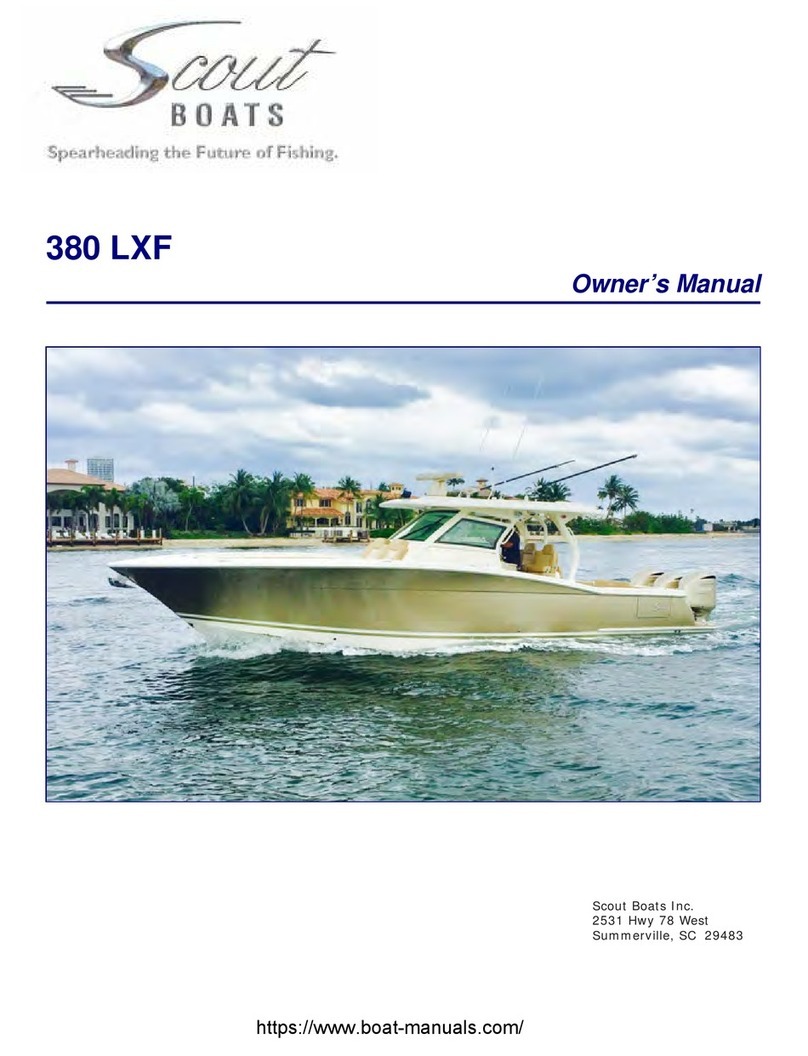
Scout Boats
Scout Boats 380 LXF owner's manual
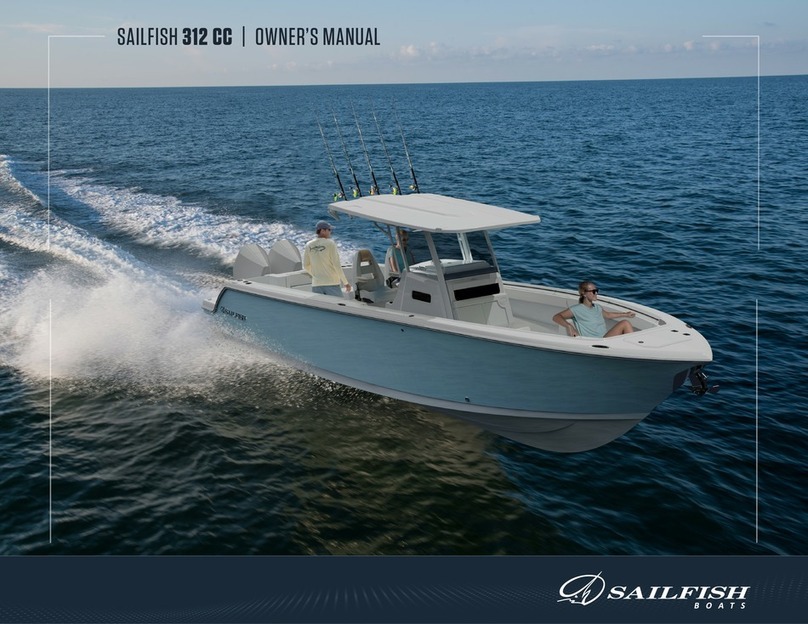
Sailfish
Sailfish 312 CC owner's manual

KeyWest Technology
KeyWest Technology 152CC/1520 Sportsman quick guide

Grady-White Boats
Grady-White Boats Express 370 owner's manual
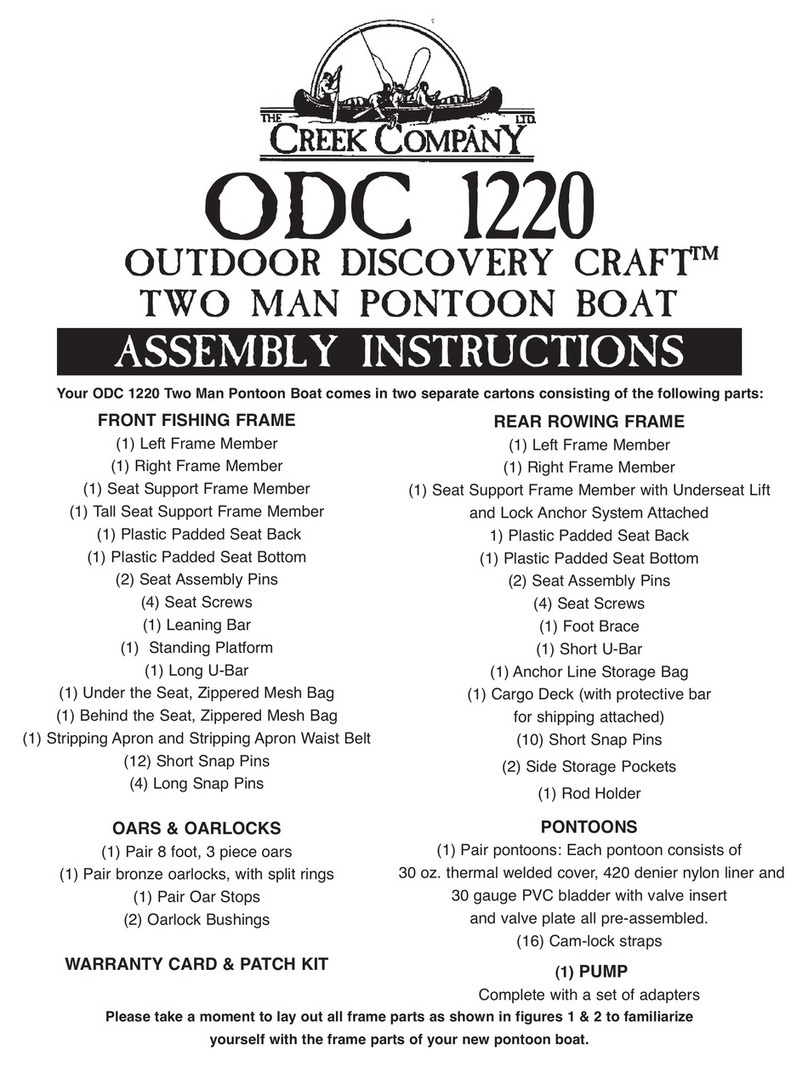
Creek Company
Creek Company ODC 1220 Assembly instructions
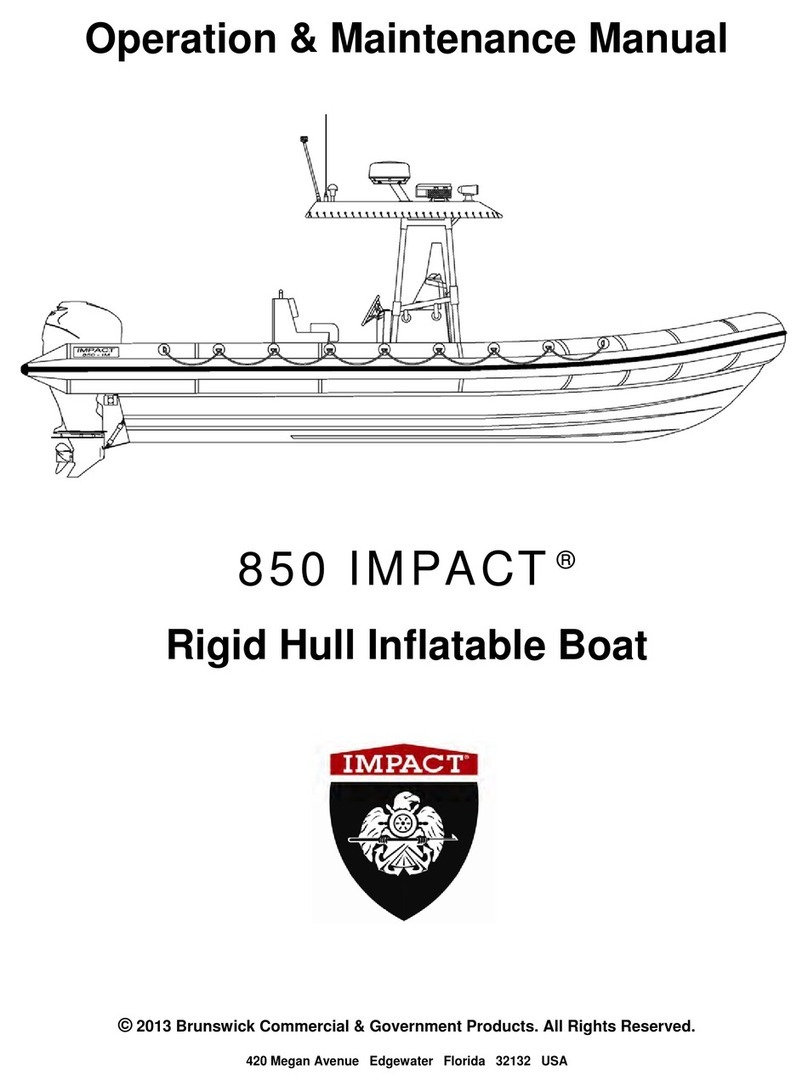
Brunswick
Brunswick 850 Impact Operation & maintenance manual

Hunter Marine
Hunter Marine 410 Operator's manual
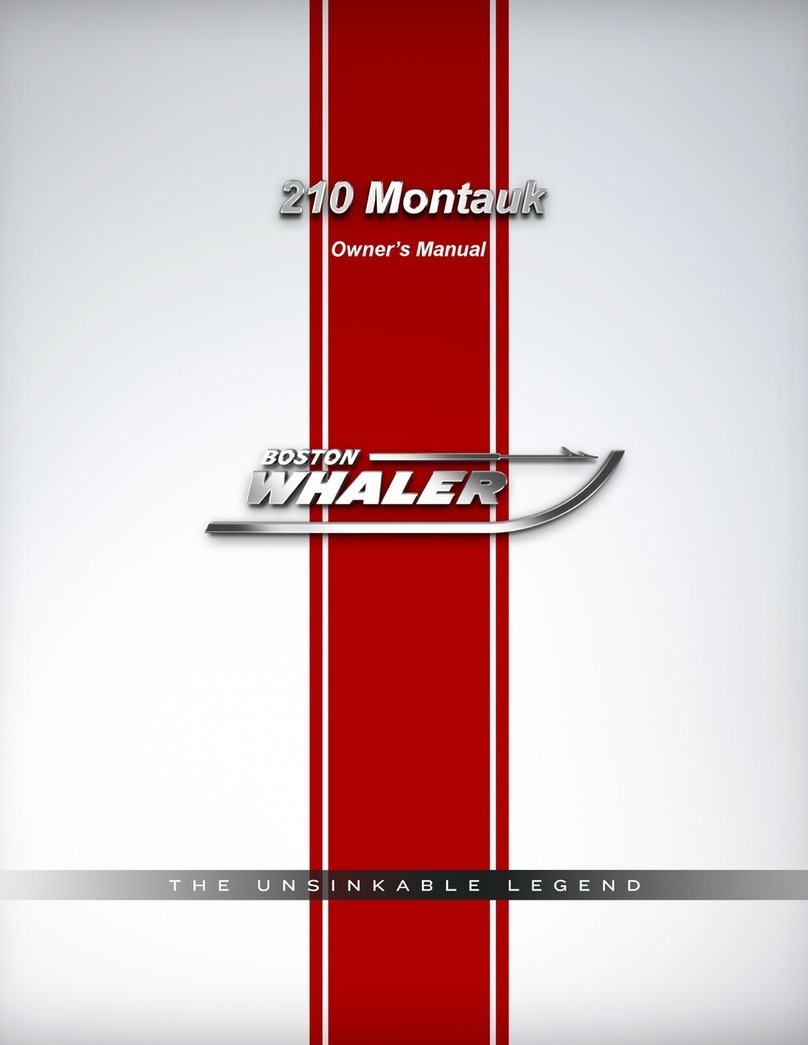
Boston Whaler
Boston Whaler 210 Montauk owner's manual
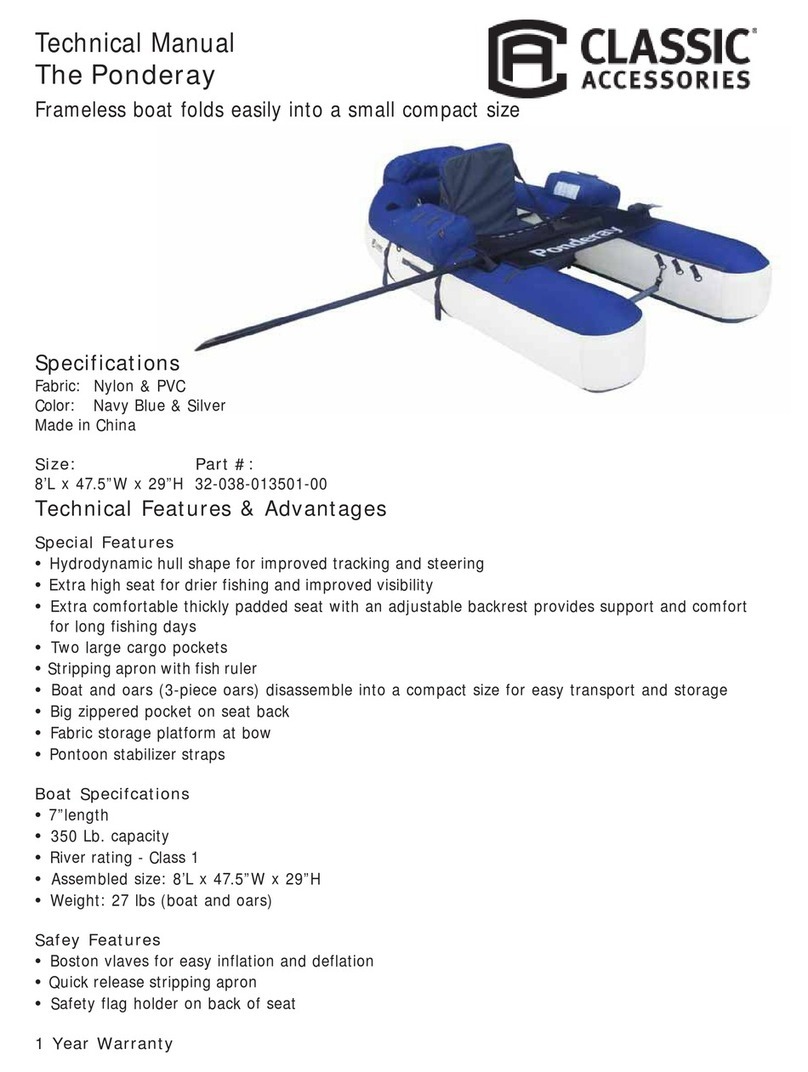
Classic Accessories
Classic Accessories The Ponderay Technical manual
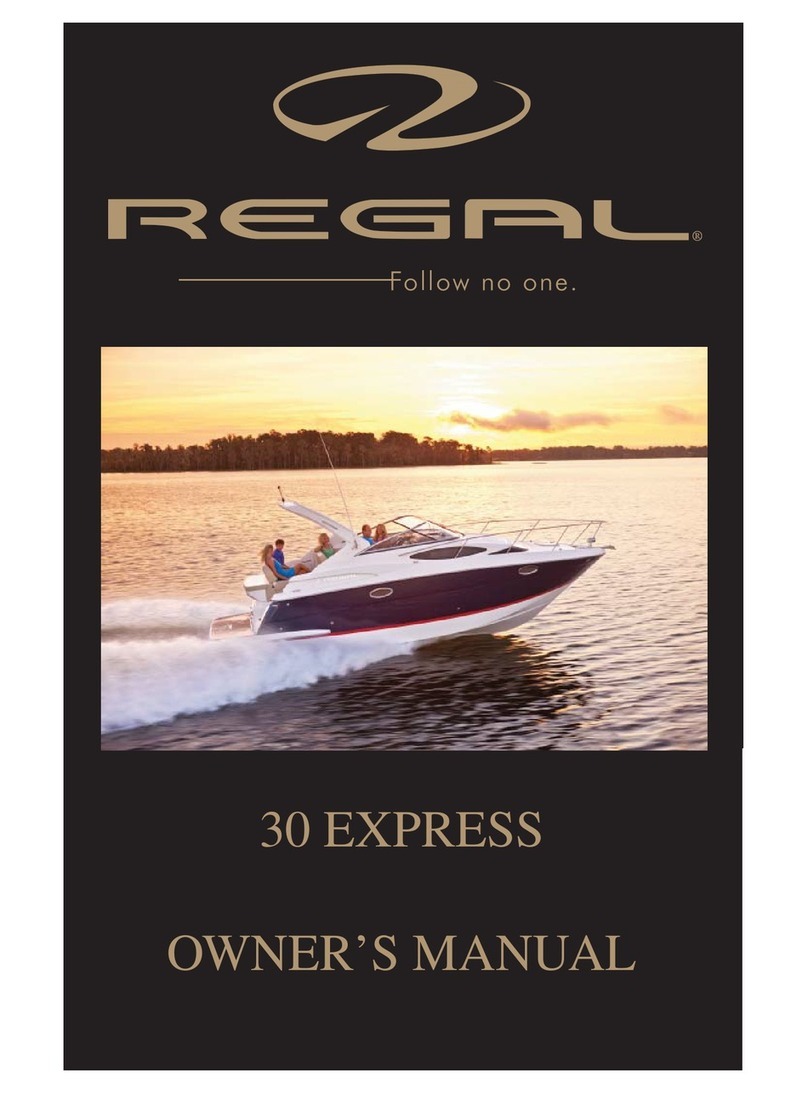
Regal
Regal 30 EXPRESS owner's manual

Yamaha
Yamaha XLT1200 WaveRunner 2005 Owner's/operator's manual

Cobalt Digital Inc
Cobalt Digital Inc 323 Day Cruiser owner's manual


